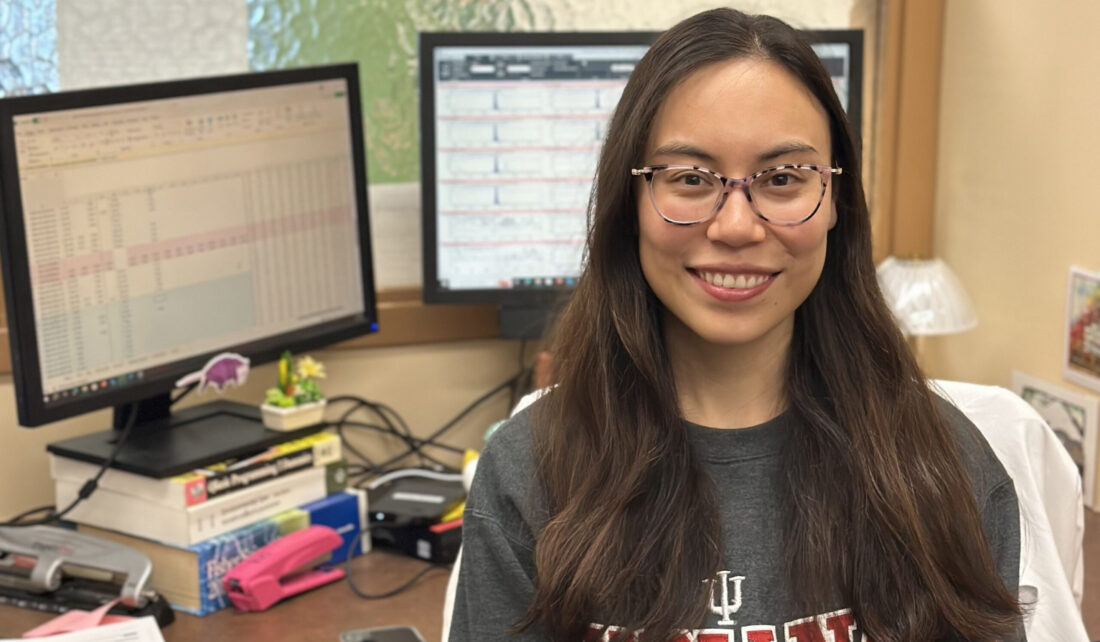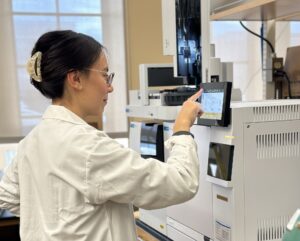
Meet Our Grad Student Scholars is a series from Illinois-Indiana Sea Grant (IISG) celebrating the students and research funded by our scholars program. To learn more about our faculty and graduate student funding opportunities, visit Fellowships & Scholarships.
Sydney Brady is a Ph.D. candidate in the environmental science program at Indiana University. She works in the Venier Lab to study the fate and transport of man-made chemicals in the environment. The work funded by IISG involves broadening the scope of her chemical analyses to better understand which synthetic chemicals are in our environment and how they are affecting ecosystem health over time.
Chemicals make our lives more convenient. They make our rain jackets waterproof, our pots non-stick, and our makeup long-lasting. They are also used for industrial purposes, like making plastic. A particularly useful class of chemicals for these purposes is called PFAS, or per- and polyfluoroalkyl substances. There are tens of thousands of PFAS molecules used and manufactured around the globe. PFAS are useful because they stick around and don’t easily degrade. However, this strength becomes an ecological nightmare when PFAS inevitably enter the environment from our wastewater and trash.
Every type of organism in the world that has been tested for PFAS has come up positive, from fish to birds to cats to dogs to people. PFAS are endocrine-disrupting chemicals and have been linked to cancer, among other negative health effects.

Sydney Brady uses analytical chemistry instruments to test bald eagle blood plasma to assess PFAS.
To figure out where PFAS are and what they’re doing, Sydney Brady researches the fate and transport of PFAS in birds collected in Michigan. Her first project focused on herring gulls and was just recently published. Of the several chemicals analyzed in that study, PFAS generally had the highest concentrations. Now, Brady’s research focuses on PFAS levels in bald eagles.
Measuring PFAS in bald eagles provides three major benefits:
- Bald eagles are at the top of the food chain, so the levels of PFAS in bald eagles represent the levels of PFAS in the organisms lower on the food pyramid. This means that we can use bald eagles as a sentinel species, or a species that can show us what the health of the entire ecosystem looks like.
- There are not many studies on chemicals in bald eagles, so this research lets us know what could be affecting bald eagle health.
- Bald eagles are really cool!

These samples of bald eagle blood plasma are used to measure PFAS contamination.
This exciting work is happening in the Venier Lab at the Indiana University Bloomington campus. Using a method that she developed herself and sophisticated analytical chemistry instruments, Brady can measure several different PFAS from just one milliliter of bald eagle blood plasma.
The first type of PFAS that Brady measures is called legacy PFAS. These include the oldest kinds of PFAS, some of which aren’t even manufactured anymore. However, because they last so long in the environment, these legacy PFAS are still found almost everywhere that researchers look for them. Many legacy PFAS have negative toxicological effects.
The second type of PFAS that Brady looks for is called precursor PFAS. These molecules are called precursors because they can turn into legacy PFAS in the environment. Precursor PFAS are still manufactured and used today. By studying both legacy and precursor PFAS, we can get a good idea of what and how much PFAS is actually in the environment.
The results of this study will be used for a variety of purposes. First, they will be used to determine where PFAS “hot spots” are in Michigan. They can also be analyzed to determine how concentrations of PFAS change over time, and whether these concentrations are having effects on the health of the bald eagles. Finally, these results can also be used to figure out whether remediation efforts are working. If an area is being remediated and concentrations of PFAS in the bald eagles are decreasing over time, then clean-up efforts are working!
So far, Brady’s work on the fate and transport of PFAS in Michigan has been presented at several conferences including the Society for Environmental Toxicology and Chemistry, Dioxin, Emerging Contaminants in the Environment Conference, and the Michigan State University Annual PFAS Symposium.
Of course, no work is completed in a vacuum (except for the parts of the experiment that are literally under vacuum pressure). Brady asserts that this work would not be possible without the hard work of Bill Bowerman, Peggy Shrum, Mandy Annis, and Amanda Curtis.
_________________________________________________________
Illinois-Indiana Sea Grant is one of 34 Sea Grant programs supported by the National Oceanic and Atmospheric Administration in coastal and Great Lakes states that encourage the wise stewardship of our marine resources through research, education, outreach and technology transfer. In partnership with the University of Illinois Extension, and Purdue University Forestry and Natural Resources, Illinois-Indiana Sea Grant brings science together with communities for solutions that work.

